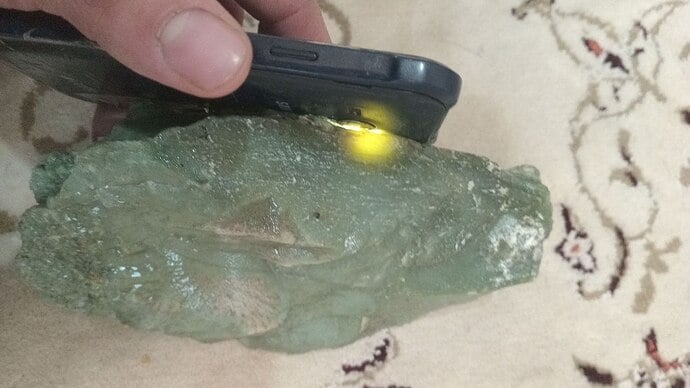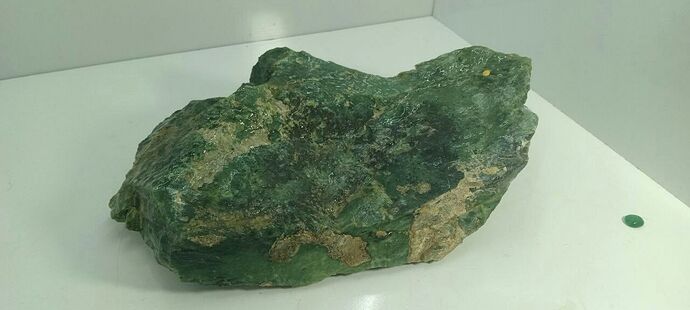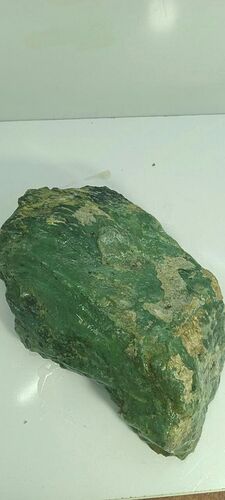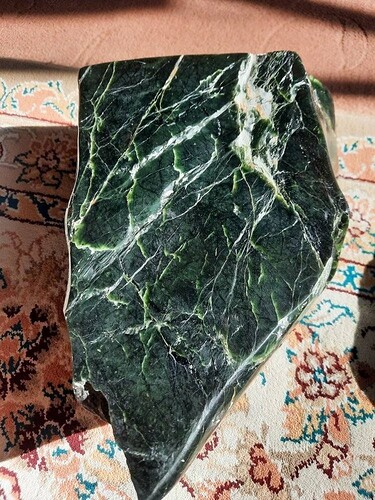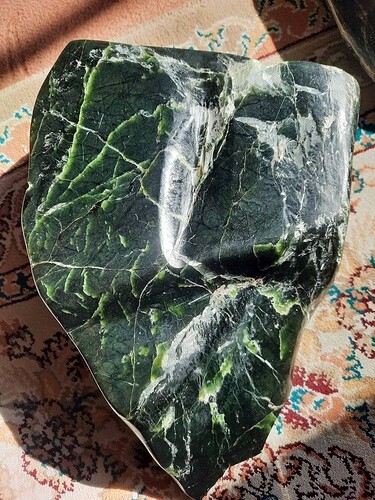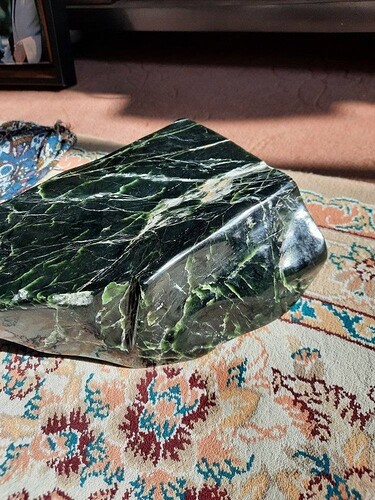Hello Dears
I have received 2pcs of high quality jadeite jade.
Please help me are my Jade’s imperial jade and how much their value?
Weight of each PC’s is about 3 kg.
Greetings,
Looking at the photos I see a few things that indicate that what you have is not jade. Both Nephrite Jade and Jadeite Jade are technically aggregates that have grown together as a massive material. They don’t have a crystalline structure, which I can see in certain areas of the stone in the photos.
Also, the luster of your material appears to be vitreous or glass like. The luster of jade is very different, often waxy or full. The color known as Imperial Green is a vivid and intense very slightly bluish green and can only be confused with emerald and glass. The color of the material in the photo is not similar. I am not sure of the identity of the stone/material in the photo but am reasonably certain it isn’t jade. I’m sorry to give you bad news and hope you can resolve the situation.
Regards,
Brian Hudson GG
GIA Graduate Gemologist
agree with BrianH. I hope that you didn’t pay a lot for it… Jade is very difficult to price. Identifying Jadeite and nephrite from rough is easier than pricing it. Telling from pictures only is also very difficult and oten unreliable. jadeite is a soda clinopyroxene ( diopside solid solution series ) that is barely silica saturated. It’s found ony in low temperture high pressure metamorphic belts of blue schist facies. Typical jadeite is more of a rock than a pure mineral, as other mineral are usually constituents it it. The structure is fibrous intergrowth of small cystals that give it toughness. Nephrite jade is a calcium, magnesium, iron amphibole with a felted fibrous intergrowth of actinolite and tremolite, giving it toughness that exceeds jadeite. The latter forms under a lower metamorphic grade, greenschist facies mostly from basaltic rock… although this is a disgression from your question, it’s relevant in that blueschist metamorphic rocks are very uncommon at the surface of the earth. That makes jadeite restricted in provenance… Myamar and Guatemala are the only two sources of high quality jadeite. Small amounts are found in obducted slabs in northern California going into British Columbia, but none either are found in abundance nor are of gem quality.
Hello Brian
Thanks for your comment .
I have received this items today and they seems to be serpentine . I will check density and hardness and will come back.
Thanks
Saeed.P
Hello Steven
You are right they are not jade and it seems they are very high quality serpentine.
will check denstiy and hardness and tell you.
Serpintinite can look like jade… in fact it’s sold as “serpentinite jade” … a misnomer. Serpentinite rocks are found in obducted oceanic slabs. The lowest metamorphic facies is the zeolite facies followed by phrenite/pumpellite, followed by greenschist… blue schist facies corresponding to 15 to 30 km depth pressure and temperatures of 200 to 500 degrees C. It creates serpentine rock from ultramafic rock and jadeite out of basalt. Alkali basalt has more sodium which is necessary for jadeite to form. These kinds of rocks are not common occurances at the earth’s surface. Serpentine and jadeite form under the same PT regimen… testing SpG and scratch hardness should tell you whether it’s jadeite or serpentinite… the latter is less dense and less hard.
Dear Brian
Please check this pictures too . hardness is 6.5-7 .
Can you take a look at this.
is this one valuble ?
Dear Steven
I received this stones today , please take a look , the hardness is 6.5 - 7.
The color is dark green and very shiny and luster.
the hardness is consistent with jadeite but again a picture is difficult to tell. jadeite is the sodium end member in a solid solution with aegrine which contains iron and sodium. it is also in solid solution with diopside which is a family of clinopyroxene minerals all in solid solution containing calcium, iron and magnesium. . Quartz should not be present under microscopic examination. Free silica would not be present in serpentine rocks unless there was retrograde metamorphism and secondary hydrothermal alteration. The white veining could be albite. associated minerals are glaucophane, lawsonite, muscovite. asbestos family minerals can also be present in serpentine rocks. Chromite can form as black grains. The raw stone should be very tough and resist a blow with a hammer at an edge. a concoidal fracture rules out jade. I can’t value jade… either nephrite or jadeite. it’s the same problem with valuing turquoise. Provenance makes a difference.
I agree - the two specimens at the top are not Jadeite or Nephrite. I am confused if the same specimen is pictured in the first 2 pictures, why does it look translucent in the first picture and opaque in the second picture? I agree pictures 2,3 an4 look like serpentine, known in the trade as “new jade” but it is not jade and is much softer - about 2.5. The second set of photos, the darker stone with white and back in it may be Nephrite, but very poor quality. I don’t think it looks like Jadeite at all. In all the photos it looks very shiny. Imperial Jade is very rare and is deep emerald green, very lush in appearance.
the first two posted picture are definitely not imperial jade nor jadeite, The massive and cut rough in the other pictures are also definitely no jadeite, Depending on where it was found, nephrite could be a possibility but if so, not of gem quality. More likely serpentinite or serpentine rock. The black slabbed rock, even if nephrite is too dark and veined to be of gem value. It would have value if carved, but the value would be for the skilled labor.
